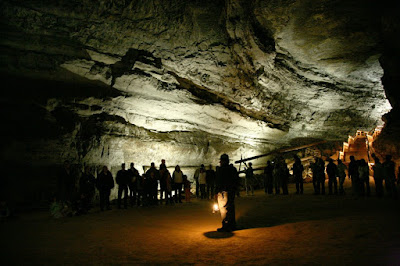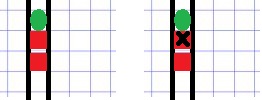 |
| Listen up! Form ranks! Prepare to move out! |
This is roughly what I’m looking at doing in my “Mass Combat In the Dungeon” scenario I was talking about yesterday. My actual scenario guide is a lot more detailed, but I can’t reproduce it as I don’t want to have parts of Delta’s Book of War given away for free. You really should think about buying this set of rules, it’s a great mass combat engine for $10!
[Edited 8/19 – after more chewing and struggling with the differences in scales/time/distances to which BoW was giving me heartburn, I’ve made some changes listed below, italicized.]
Per Book of War Core Rules (available for free here): 1 Figure = 10 men. 1″ = 20′, 1 turn = 3 minutes
Non-Combat Speed: 1/3d the movement rates in 3 minutes. (12” w/b 4”/80’ in 3 minutes)
Basic and Advanced Rules are assumed. The “enclosed space” rules from Optional Rules 6. Castles & Ships is assumed, except as noted below.
1. For combat situations where one or both sides are <10 individuals (scale is 10:1), fight on 1:1 scale. Scales revert to “standard” D&D.
- 1.1 In the case of one side with <10 individuals and the other side consists of a unit of figures, combat is with nearest figure to the opponents.
- 1.2 If one side kills all 10 individuals in a figure, then the next closest figure enters 1:1 combat with victor only if that figure was in base contact with the losing figure.
- 1.3 Example: Two figures of light footmen come into contact with a single devil.
Combat goes into 1:1 combat. The devil, being rather powerful, kills all ten of the poor footmen in the first figure. (X). Since the unit of light footmen was in a column formation, base-to-base, the second figure will now go into 1:1 combat with the devil. This will probably not end well for them either.
2. Morale rules are in full effect for Book of War combat for units. For situations where a fight on 1:1 scale [1] results in deaths to individuals within a figure, make a morale check on the figure, per Basic Rules 5. Morale – substituting “individuals” for “figure”.
- 2.1 If the figure makes its check, it may continue as a figure, but it is considered “diminished.” [3]
- 2.2 If the figure fails morale, then it is considered routed and flees with the intent on exiting the dungeon or returning to a logical area that serves as a “lair”.
- 2.3 If, before exiting, a routed figure comes within 12″ of a Hero or a unit/figure containing a leader type (subject to player agreement and/or GM ruling), the figure/unit may make another morale check. If the recovery succeeds, the figure may move to rejoin its original unit (or similar unit where applicable) but is considered “diminished.” [3].
- 2.4 Note that routed figures will require time for movement, both in the routing away, and returning (if applicable). Locations of individual figures and their movement will need to be carefully tracked.
3. A “diminished” figure represents a figure with casualties caused by a 1:1 combat. Diminished figures have a penalty of -1 to their attack rolls. If the figure is part of a unit, its status will need to be tracked.
4. Horse mounted/large animal mounted units most likely will not be present in the underground unless the scenario and area are large enough to permit mounted creatures. Horses typically do not go into dungeons.
5. Indirect fire is not permitted, unless the area that combat takes place in is large enough (such as a huge cavern that has the space. DM/players should discuss beforehand and come to agreement. In “normal” dungeon type corridors, this is not allowed.
6. Movement is per Book of War standard scale. If a unit wants to move carefully, checking for traps, mapping, etc., movement rate is halved.
7. Formations – the standard formation is a single column. We are making allowances in that most dungeons are 10′ wide columns, but Book of War scale is 1″ = 20′.
- 7.1 Large scale movements like wheeling columns, changing formations of an entire unit, changing face are not possible unless the area the unit is in permits such actions.
- 7.2 Figures may make movements on an individual basis, such as in “filling in space” upon entering a room to form a multi-figure wide “front”. Such movements must not exceed a figure’s movement allowance for that turn.

- 7.3 After a movement to “fill into a room”, a unit must spend a turn reorganizing into a single column to exit the room.
8. Figures are assumed to have a light source. If their light source is removed, they suffer the effects of “Darkness” found in Optional Rules 2. Darkness.
9. Traps and their effects generally affect the figure closest to the trap. If the trap can only affect 1 person, then ignore the trap.
- 9.1 Trap damage is adjudicated per Advanced Rules 1. Conversion / Magic Area Attacks. Traps damage ratings are based on the xd6 of trap damage caused, x becomes the damage rating.
- 9.2 Saving throws reduce damage per Advanced Rules 1. Conversion / Magic Area Attacks.
10. Creatures that are not traps, but are single entities and can affect more than 1 person (molds, oozes) or spell effects that could affect a figure, adjudicate either on a 1:1 level (and see “Diminished” [3]) or apply to a figure as a “hit” if possible. If the creature can only affect 1 person, ignore it.
I imagine that mass combat inside will look a lot like this melee…
Design Notes: (Added 8/19)
The differences in scales/distance/time from Delta’s Book of War and what I’ve learned/accepted in my D&D gave me huge headaches.
To whit: in Book of War, a light footman can move 12″ a “BoW-turn”, which translates to 240′ in thirty seconds. That’s boogeying, but then, I had to retrain my brain to remember that we’re at 10:1 scale, which kept throwing me, the scale of the thing. Typical D&D is at 1:1, BoW is at 10:1. I had to shift gears.
To make a translation to something that “feels” correct in terms of movement and combat within a dungeon at 10:1 scale, I’ve made the “BoW-turn” equal to 3 minutes – 3 1 minute D&D rounds. Delta had suggested this in notes I found on his blog and in the book.
For non-combat movement, to reflect mapping/exploring, I’ve cut the movement by a third, which translates to 80′ in a 3 minute chunk of time. Given this is a large force moving cautiously through a smaller area, this feels correct to me. I’m not skilled enough at the math to know if this is consistent with Delta’s math, but it reflects what I would expect from a large force invading a dungeon.

